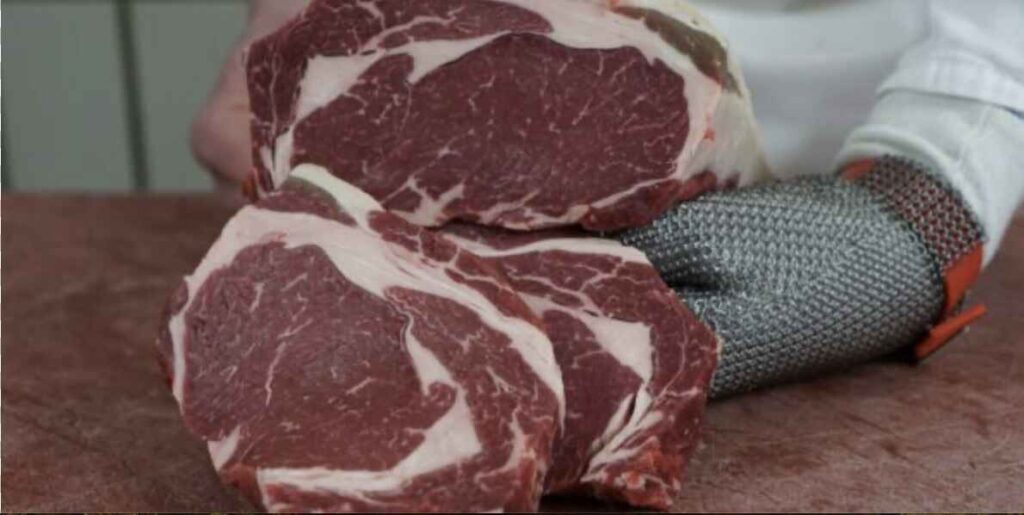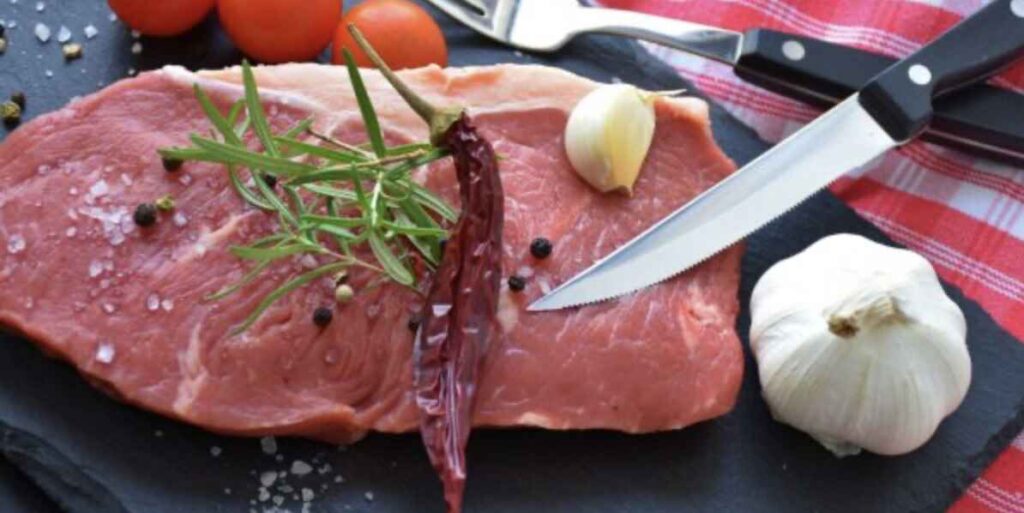Ordering the perfect beef steak can feel overwhelming, especially if you’re unfamiliar with the cuts, doneness levels, and how to communicate your preferences to the waiter. Whether you’re dining at a high-end steakhouse or a casual restaurant, knowing how to choose and order the best steak will elevate your experience. This guide will help you understand the ins and outs of ordering beef steak to ensure you get the best cut and preparation every time.
Table of contents
Understanding Different Cuts of Beef Steak
When ordering a steak, the first thing to consider is the cut of beef. Each cut offers distinct flavors, textures, and price points. To make an informed decision, it’s essential to understand the differences between popular steak cuts.
Ribeye: The Steak Lover’s Favorite
- Rich Marbling for Unmatched Juiciness: Renowned for its intramuscular fat, the ribeye delivers a buttery texture and robust beefy flavor as the fat melts during cooking.
- Cut From the Rib Section: Striking the perfect balance between tender meat and savory fat, this cut is ideal for grilling, pan-searing, or broiling.
- Best Served Medium-Rare or Medium: To bring out its juiciness and texture, the ribeye is most flavorful when cooked to medium-rare or medium doneness.
Filet Mignon: Luxury in Every Bite
- Exceptionally Tender and Lean: Taken from the tenderloin, filet mignon stands out for its melt-in-your-mouth experience, compensating for its lower fat content.
- Fine, Buttery Consistency: Known for its delicate texture, this cut is best cooked medium-rare or medium to preserve its soft interior.
- A Refined Steak Option: If you prefer a subtle, tender steak over one with bold marbling, filet mignon is a perfect choice.
T-Bone and Porterhouse: Two Steaks in One
- Iconic T-Shaped Bone: Famous for combining tenderloin and strip steak, these cuts offer a versatile and flavorful dining experience.
- Porterhouse vs. T-Bone: While both are exceptional, the Porterhouse features more tenderloin, making it slightly more indulgent than the T-Bone.
- Perfect for Grilling: Moreover, the bone enhances flavor retention and moisture, ensuring a juicy, satisfying steak.
Beef Sourcing and Quality Grades
- Grass-Fed vs. Grain-Fed: Furthermore, understanding the beef’s sourcing can help you select flavors that match your preferences.
- Understanding USDA Beef Grades: To make an informed decision, consider learning about USDA beef quality grades.
How to Choose the Right Cut for Your Meal
- For Special Occasions: If you’re celebrating, cuts like filet mignon or T-bone steaks add an elegant touch.
- For Rich, Juicy Flavors: On the other hand, a ribeye is the go-to choice for a steak packed with marbling and flavor.
- For a Leaner Choice: Alternatively, sirloin or New York strip provide less fat but maintain excellent taste.
- Ask About Preparation: Finally, don’t hesitate to inquire about the restaurant’s signature cooking methods to ensure your steak is prepared to perfection.
How to Choose the Right Cut for Your Meal
- For Special Occasions: Filet mignon or T-bone steaks make excellent celebratory options.
- For Rich, Juicy Flavors: Opt for a ribeye with its flavorful marbling.
- For a Leaner Choice: Choose sirloin or New York strip for less fat but great taste.
- Ask About Preparation: Inquire about the restaurant’s grilling or searing methods for the best dining experience.
Understanding Steak Doneness Levels

Once you’ve selected your cut, the next important decision is how you want your steak cooked. Steak doneness levels are key to ensuring your steak is prepared exactly how you like it.
Steak Doneness Guide
- Rare: Red center, very soft texture. Cooked for about 2-3 minutes per side.
- Medium Rare: Warm red center with a slightly brown exterior. Cooked for 3-4 minutes per side.
- Medium: Pink throughout with firm texture. Cooked for 4-5 minutes per side.
- Medium Well: Slightly pink in the center, firmer texture. Cooked for 5-6 minutes per side.
- Well Done: Fully cooked with no pink. Cooked for 6+ minutes per side.
The most popular doneness is medium-rare, as it preserves both the juiciness and flavor of the steak. When ordering, make sure to clearly specify your preference. For instance, say, “I’d like my steak medium-rare with a warm red center.”
If you’re uncertain about which doneness level is right for your steak, feel free to ask the waiter for their advice based on the cut you’ve chosen. Steakhouse staff are often very knowledgeable and can help guide you to the perfect doneness level.
How to Order the Perfect Steak
Now that you’ve selected your cut and doneness, it’s time to place your order. Here are some tips to ensure that you get the best steak possible:
Preparing Before You Order
- Do your research: Review the menu in advance so you know which cuts are available and how they are prepared.
- Ask about beef sourcing: If you’re interested in sustainable beef or grass-fed beef, ask the waiter for more information. Many upscale steakhouses feature these options. For further reading, here’s a helpful guide on sustainability in beef sourcing. Read more here.
Ask for Recommendations
Don’t be afraid to ask the waiter for their expert recommendation based on your preferences. They can suggest cuts that are in season or ones that the restaurant is known for preparing exceptionally well.
Questions to Ask the Waiter
- “Is the steak grass-fed or grain-fed?”
- “How is the steak prepared? Do you grill, sear, or use a special technique?”
- “What sides pair best with this cut?”
- “Do you offer any signature sauces or toppings?”
These questions will give you insight into the quality and preparation methods of the steak, ensuring you get the perfect meal.
Pairing Your Steak with Sides and Beverages
The right side dishes and beverages can complement your steak and take your meal to the next level.
Best Side Dishes for Steak
- Mashed potatoes or roasted potatoes: These classic side dishes pair perfectly with rich cuts like ribeye.
- Grilled asparagus or roasted vegetables: Light, flavorful sides that balance the richness of a fatty steak.
- Fresh salad: A crisp salad is a great way to cut through the heaviness of steak.
Wine Pairing with Steak
Wine is a classic pairing with beef steak. Here are a few options to consider:
- Cabernet Sauvignon: Pairs excellently with rich cuts like ribeye.
- Merlot: Works well with leaner cuts like filet mignon or New York strip.
Complementary Sauces and Toppings
Many steak lovers enjoy adding a sauce or topping to their steak. Popular choices include:
- Béarnaise sauce: Rich and creamy, this sauce complements tender cuts like filet mignon.
- Peppercorn sauce: A savory, slightly spicy addition to a ribeye or T-bone.
- Chimichurri: A tangy, herb-based sauce that pairs perfectly with grilled steaks.
Customer Etiquette When Ordering Steak

Being polite and respectful when ordering your steak ensures a smooth dining experience. Here are some basic etiquette tips:
- Be clear and concise: When stating your preferences, be direct but polite. For example, “I’d like my steak medium-rare, please.”
- Be patient: Preparing a perfect steak takes time, especially if you’ve chosen a high-quality cut. Give the kitchen time to cook it to your liking.
- Don’t hesitate to ask for adjustments: If your steak isn’t cooked to your liking, ask the waiter if they can adjust it. Most restaurants are happy to accommodate.
FAQs About Ordering Beef Steak
1. How do I know what steak to order at a restaurant?
Start by considering your taste preferences—do you enjoy fatty cuts or leaner steaks? For a rich, juicy steak, go for a ribeye. If you prefer tenderness, filet mignon is a great option.
2. How can I tell if the steak is cooked to my liking?
You can test the firmness of the steak with your finger. A medium-rare steak should be soft but slightly firm to the touch. You can also ask the waiter to check the doneness for you.
3. What is the best steak for beginners?
For beginners, cuts like sirloin or New York strip are ideal because they are flavorful, versatile, and easier on the budget.
4. What should I ask the waiter when ordering steak?
Be sure to inquire about the sourcing of the beef, how the steak is prepared, and any recommended sauces or sides. Asking these questions will enhance your steak experience.
5. What are the different steak cuts, and what are they best for?
Each steak cut offers something unique. Ribeye is best for rich flavor, while filet mignon is known for its tenderness. If you prefer leaner options, sirloin or New York strip are excellent choices.
With these tips and knowledge, you can confidently order the perfect beef steak every time. Whether you’re at a casual diner or a high-end steakhouse, understanding how to choose your cut, specify doneness, and pair your steak with the right sides and drinks will enhance your dining experience.
The most common beef steak recipe
One of the most famous beef steak recipes in the United States is the Classic American Ribeye Steak, often cooked simply to let the natural flavors of the beef shine. Here’s how to make it:
Classic American Ribeye Steak Recipe
Ingredients:
2 ribeye steaks (1 to 1.5 inches thick)
2 tablespoons olive oil
4 cloves garlic, minced
Fresh thyme or rosemary sprigs
Salt and freshly ground black pepper (to taste)
2 tablespoons butter
Instructions:
Prepare the Steaks: Remove the ribeye steaks from the refrigerator and let them come to room temperature for 20-30 minutes. This helps them cook more evenly.
Season the Steaks: Generously season both sides of the steaks with salt and freshly ground black pepper. Optionally, rub the steaks with minced garlic for added flavor.
Preheat the Pan: Heat a cast-iron skillet or grill pan over medium-high heat. Add the olive oil and allow it to heat up.
Sear the Steaks: Place the steaks in the hot pan. Sear each side for about 4-5 minutes, depending on your preferred level of doneness. For medium-rare, aim for an internal temperature of 130-135°F (54-57°C).
Add Butter and Herbs: During the last minute of cooking, add butter and fresh thyme or rosemary to the pan. Tilt the pan and spoon the melted butter over the steaks to infuse them with flavor.
Rest and Serve: Remove the steaks from the pan and let them rest for 5-10 minutes to retain their juices. Serve with your favorite sides like mashed potatoes, grilled vegetables, or a simple salad.
This ribeye steak recipe showcases the bold, juicy flavor of the cut, with minimal ingredients to allow the steak to truly shine. It’s a go-to dish for many steak enthusiasts in the U.S. and a staple at American steakhouses.

